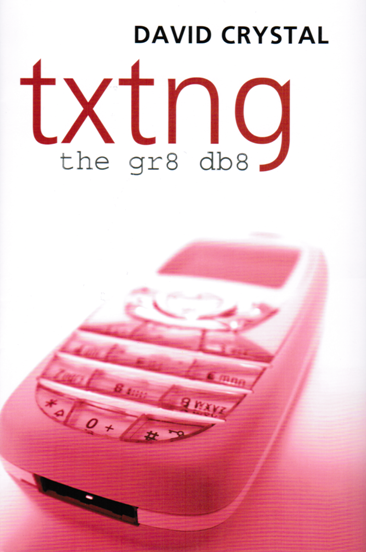
Txtng: The Gr8 Db8
by David Crystal
To naysayers of text messaging, who fret that the thumb-twisting communication technique stunts literacy and impoverishes the language, David Crystal might ask, is LOL really so different from RIP?
In sentiment, certainly, but in impact on language and learning, not at all, Crystal would say. In this compact volume – roughly the size of six iPhones – Crystal offers a thorough study of text messaging, including who uses it, why, what they say, how they say it, and how foreign language speakers do it. Texting, he argues, is simply a continuation of commonplace manipulations of language, and, potentially, a powerful new mode of interaction.
Texting came slowly to the U.S., relative to Europe and Asia, because Americans grew accustomed to constant email access, instant messaging, and cell phone plans promising “free” minutes long before they encountered the low-cost text, and the potency of 160 characters conveying messages of all kinds with abbreviations, emoticons, and acronyms. Americans are catching up, though: in 2006, Americans sent 158 billion text messages, a 95% increase over the previous year. By 2010, according to one study Crystal cites, people around the world will send 2.4 trillion texts annually.
Clearly, a billion texters can’t be wrong. Crystal, a linguistics expert and author of several books on the evolution of languages, explains briefly some of the basic reasons why the medium has taken off: it’s efficient and inexpensive, immediate and private. The increasing availability of phones with full keyboards, too, makes texting more practical, and possibly more like IM conversations.
But a billion texters could be destroying language, or so some fear. Crystal cites the possibly apocryphal horror stories of teens turning in school reports filled with text-speak; he dismisses this as the “linguistic equivalent of walking into class wearing a hoodie” (a more meaningful garment in Crystal’s U.K. than here). But text-speak, Crystal argues, is no different from normal evolutions of the language.
Of the six distinctive features of texting – pictograms and logograms, the use of initials, omitted letters, nonstandard spelling, and shortened words – none is new. Crystal compares pictograms and logograms (numbers or symbols representing words or parts of words, like “U” for “you”) to the rebus, drawn by Leonardo da Vinci and Lewis Carroll. Initials are still more common, filling lexicons of various industries and appearing in common usage since the 17th century (the advent of NB or nota bene). Omitted letters, too, appear in titles like “Mr.” Some unusual spellings are found in the Oxford English Dictionary, and languages like Arabic and Hebrew customarily skip vowels. Shortened words like “exam” are common. But texting has raised some novelties, too, like the language play of the expansive family of phrases grown from “IMO” or “in my opinion” (IMHO, IMCO, IMHBCO), the haiku-like text poem, or the serially published text novels.
The language play in text messaging serves those essential, but opposite, social purposes – fitting in and standing out. It makes for more urgent, declarative communication, mostly free of greetings, salutations and polite phrases. But texting, as its doubters would be loathe to admit, has a still deeper social impact, transforming relationships and their conduct. “The changes in our communicative behavior, and in our expectations about the communicative behavior of others, are quite striking,” Crystal writes. “Text messaging seems to have increased our expectation that we are mutually accessible.”
Texting is intimacy, mediated. It is urgent but withdrawn, the ultimate tease. For those who doubt the text’s romantic possibilities, a short text message can be as anxiously awaited – and its absence as desperately missed – as a love letter in centuries past. “To those who text,” Crystal writes, “the beep heralding a new message invariably thrills, not pains.”
Excerpt: “Faced with a new kind of communication problem, presented by mobile phone technology, people all over the world have set about solving it in the same kind of way. They have done so, not by inventing a new language, but by adapting old language to suit the new medium. It is not the first time people have adapted language to meet the needs of new technological circumstances. The arrival of printing, wireless telegraphy, telephony, broadcasting and the Internet all pulled language and languages in fresh directions, introducing new standards and styles.”
Further Reading: How Language Works and Always On: Language in an Online and Mobile World




Send A Letter To the Editors